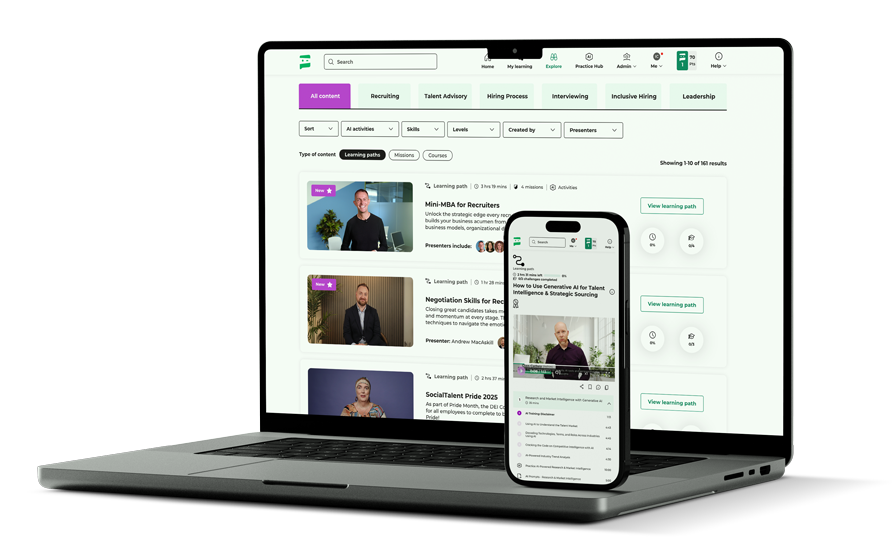The Worst Behavioral Interview Questions (and How to Fix Them)
Picture this: You’re in an interview, expecting insightful answers, but instead, you’re met with blank stares, vague responses, or just plain confusion. It’s not that the candidate lacks experience – it’s that the question itself was… well, pretty bad.
Behavioral interview questions are meant to reveal how a candidate thinks, acts, and solves problems. But too often, they end up doing the opposite. Bad behavioral questions can be confusing, vague, or closed-ended – leaving both the interviewer and the candidate frustrated.
So, why do these questions go wrong? As Holly Fawcett, our amazing Director of Content at SocialTalent, puts it in her course on behavioral interviewing:
“Bad behavioral interview questions are closed questions, where they’re asked to be answered with a ‘yes’ or ‘no’ response. They can also be questions that are really vague, or worded poorly and confuse the candidate.“
According to an Albright guide on the topic, behavioral interview questions are said to be 55% more predictive of on-the-job success compared to traditional interviewing. So it’s important to get them right.
In this article, we’ll break down what makes a behavioral interview question bad, share some common offenders, and – most importantly – show you how to fix them. You’ll also get some practical tips on how to keep your questions clear, engaging, and genuinely insightful.

Why Do Bad Behavioral Interview Questions Happen?
Even the most seasoned interviewers can slip up when crafting behavioral questions. The problem isn’t usually a lack of effort – it’s often a combination of overthinking, under-preparing, or just plain trying too hard.
Let’s break down why these mistakes happen – and why they matter.
1. The Over-Think: Trying to Sound Clever
Some interviewers fall into the trap of crafting elaborate, quirky questions in the hopes of appearing insightful or original. But guess what? Complexity doesn’t equal clarity.
- Example: “If your past work experiences were a novel, what genre would they be?“
- Why It Fails: The candidate is left guessing what the interviewer actually wants to know.
- Fix: Just avoid these full stop. Laszlo Bock, Google’s former SVP of People Ops, even once famously said that: “Brainteasers are a complete waste of time. They don’t predict anything. They serve primarily to make the interviewer feel smart.”
2. The Unclear Approach: No Preparation
Imagine this: You jot down a phrase like “problem-solving” to remind you to ask a question about this, but when the time comes, you fumble through it. The result? A vague, half-formed question that confuses everyone.
- Example: “Problem-solving… um… talk to me about that?“
- Why It Fails: The candidate has no context or direction, leading to scattered answers.
- Fix: Write out the full question ahead of time, rather than relying on a single word to jog your memory. Example: “Tell me about a time when you faced a significant problem at work. How did you approach it, and what was the outcome?“
3. The Closed Question Trap: Yes or No Responses
Behavioral questions should encourage storytelling – not shut it down. If your question can be answered with a simple “yes” or “no,” it’s not going to reveal much.
- Example: “Did you work on any major projects at your last job?“
- Why It Fails: Even if the answer is yes, it doesn’t reveal how they approached the project or what they achieved. Candidates should be encouraged to give context and explain their actions.
- Fix: Frame it as a story prompt: “Tell me about a time you worked on a significant project. What was your role, and what did you learn?”
4. The Broad Question: Leaving Too Much to Interpretation
Some behavioral questions are so broad or clichéd that candidates can fall back on rehearsed narratives. Nearly anyone can anticipate and prepare a cookie-cutter response about “a team conflict”.
- Example: “How have you addressed team conflict in the past?“
- Why It Fails: If questions become too predictable, you risk getting pre-packaged answers that don’t genuinely distinguish candidates.
- Fix: Questions should be specific to contexts relevant to the job: “In your previous role, you would have had to manage a lot of different stakeholders at different levels. How did you keep teams aligned and pushing for the same goal?“
Bad behavioral questions aren’t just awkward – they can derail the entire interview and also prove disastrous for your employer brand. The good news? With a little structure and preparation, you can transform confusing questions into conversation starters.
How to Structure Good Behavioral Interview Questions
In her SocialTalent course, Holly points out something really important: you don’t have to worry too much about “bad” questions if you know how to recover and clarify. Ideally, you’ll want to structure your questions in a way that minimizes the risk of confusion in the first place. But we’re all human. And understanding how to ask good behavioral interview questions is the first port of call.
The Formula for Success:
The best behavioral interview questions are:
- Open-ended – They prompt a story rather than a yes/no answer.
- Focused on Real Scenarios – They encourage the candidate to discuss past experiences.
- Clear and Specific – They make it easy for the candidate to understand what you’re asking.
- Probing – They encourage deeper insights through follow-up questions.
1. Start with an Open Prompt
One of the easiest ways to kick off a strong behavioral question is to use a phrase that invites storytelling. We recommend phrases like:
- “Tell me about a time when…”
- “Give me an example of how you…”
- “Describe a situation where you…”
Example:
- “Tell me about a time when you had to manage a difficult client relationship. How did you handle it, and what was the outcome?”
2. Add Context to Guide the Response
As we know, vague questions lead to vague answers. Make your questions as specific as possible without overwhelming the candidate. Don’t reel off a list of scenarios, but reference key areas which will be important for the role.
Example:
- “Describe a situation where you had to balance competing priorities on a project. What strategies did you use to stay on track?”
3. Use Probing Follow-Ups
Good behavioral questions often spark more questions. Be ready to dig deeper into their initial response to get the full picture. This also helps to break through any stock, pre-prepared answers.
Follow-Up Prompts:
- “What was the most challenging part of that situation?”
- “How did your team react to your approach?”
- “What would you do differently if you faced a similar challenge again?”
4. Focus on Positive Framing
Behavioral questions don’t have to be negative to be insightful. Instead of only asking about failures or challenges, balance them with questions about successes and achievements. As the old adage goes, they’re interviewing you as much as you’re interviewing them. Positivity helps calm the nerves and gives candidates a forum to shine.
Example:
- “Tell me about a project you’re particularly proud of. What made it successful?”
5. Use the STAR Method as a Guide
Even if you don’t explicitly tell the candidate to use the STAR method (Situation, Task, Action, Result), you can structure your questions in a way that naturally elicits this kind of response.
Example:
- “Can you describe a challenging project (Situation), what your main goal was (Task), the steps you took to complete it (Action), and what the final outcome was (Result)?”
By structuring your questions with intention and clarity, you’ll not only make the interview smoother but also get far more insightful answers. As Holly says, it’s all about giving candidates the opportunity to “tell the story” and then actively listening so you can probe deeper when needed.
Conclusion: Make Behavioral Questions Your Best Asset
Behavioral interview questions have the potential to be your greatest tool for uncovering a candidate’s true abilities and mindset – but only if you get them right. Bad questions can derail an interview, confuse candidates, and leave you with vague or misleading insights.
The good news? Crafting effective behavioral questions doesn’t have to be complicated. By focusing on clarity, structure, and relevance, you can turn awkward conversations into insightful discussions.
When in doubt, remember these key takeaways:
- Open-ended over closed: Start with “Tell me about a time…” to prompt storytelling.
- Clarity over cleverness: Avoid trick questions or overly philosophical prompts.
- Context over confusion: Be specific about the situation you’re asking about.
- Active listening over scripted questioning: Follow up with probing questions to dig deeper.
By putting in a bit more thought and preparation, you’ll not only get more genuine responses but also build a more engaging and comfortable interview experience. Candidates will thank you – and so will your hiring outcomes.
Talk to the SocialTalent team and learn how our platform can help you develop smarter, more effective interview techniques.




